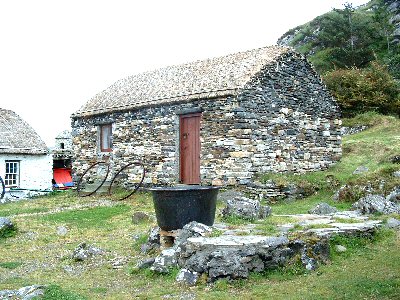I find it maddening in the extreme – given that all of my forebears suffered untold hardships in this vicinity through the years of the Great Hunger of the mid-nineteenth century in Ireland – to hear a supposed authority like the former head of PRONI [named below] – at a public meeting recently in Newry – claim that our area was little affected.
An actual Famine Soup pot, used in Donegal!
Since he had control of the extant records of the period, he ought to know better. You the reader can glean the truth from History of Newry Workhouse.
Despite this you might wonder, perhaps, whether the situation was less severe in the rural heartland of South Armagh, which came under the Castleblaney and Dundalk Poor Law Unions?
To the contrary! It was much more severe.
The evidence given to ‘The Commission for inquiring into the conditions of the Poorer Classes in Ireland [1836]’ and ‘The Report of the Devon commission [1845]’ portrayed conditions in rural Ireland – and especially in the parishes of Upper Creggan and Lower Creggan, as even more backward than those in towns.
Overpopulation relative to agricultural conditions imposed at the time – the total dependence of the cottier and labouring class on the potato, – insecure tenure and subsistence farming were all contributory factors which left a large proportion of the population vulnerable to a cyclical virus of one crop [the potato: the virus identified only decades later as Phytophthora Infestans] leading to a ‘famine’ of catastrophic proportions.
This article concentrates on the named parishes as that other did on the Newry Union. Perhaps the population statistics – deaths from famine and disease and enforced emigration – best tell the story.
The population of Upper Creggan, which had, like the rest of Ireland been rising at double figure levels for decades, dropped by 17.6% between the 1841 and 1851 censuses [the worst was over by that latter date, but famine effects persisted for at least another year].
The population of Lower Creggan [a smaller parish] dropped by 16.7% over the same period. This was higher than the county drop [16%] if slightly lower than the national average of 20%. The West and South West were especially hard-hit, but the percentage in not as radically different as Dr Treanor or others would have you believe.
Statistics hide a multitude of personal and family calamities. They also help to disguise the disaster that befell the most vulnerable, cottiers and labourers who held no lease and were the first, and the hardest to be hit. Whereas the total number of houses in the two parishes dropped from 5,105 to 4,436 over the period, an 11% drop, homes in the Class IV category – one-roomed cabins – declined by 77%, from 1,488 to 346. Their former tenants formed a disproportionate fraction of those forced onto the roads, into workhouses and onto the coffin ships.
The Commission {1836} interviewed clergymen of the parishes and other local notables about living conditions. The general consensus was that the poor lived on potatoes and a little milk, except during the winter when milk was unavailable. Though oats were grown as a cash crop [to pay the rent and tithes (a compulsory payment to support the Established Church, obligatory even on Roman Catholics)] some poor lived on oaten porridge too.
The [Protestant] Rector of Creggan said that clothing was poor but warm, mainly of frieze: the others, that generally people couldn’t afford frieze, although it was freely on sale at fairs: their clothing was ‘miserable indeed’, ‘a variety of shreds and patches’; that the poor were ‘very badly clothed’. Estimates of labourer’s wages varied from
